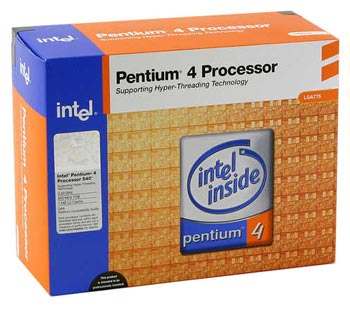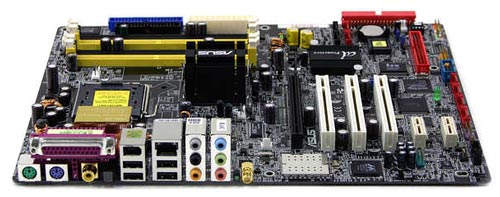Overclocking Buyer's Guide - September 2004
by Wesley Fink on September 17, 2004 12:05 AM EST- Posted in
- Guides
CPU and Motherboard: PERFORMANCE OC Alternatives
CPU: Intel Pentium 4 540 (3.2Ghz)Motherboard: Asus P5AD2 Premium (Intel 925X)
Price: CPU - $224 shipped (Retail with HSF). Motherboard - $260 shipped
This month, it was particularly difficult to decide between the Single-Channel Socket 754 Athlon 64 and the new Intel Socket 775 for the Performance Overclocking alternative. Despite the massive increase in memory bandwidth that comes with the Dual-Channel 939, the fact remains that the Athlon 64 is not particularly bandwidth-starved compared to recent deep-pipe Intel designs. As you can see in the launch article on Socket 939, this translates into performance of the single-channel 754 Athlon 64 that is only 2% to 9% slower than the new 939 at the same speed. In real terms, this means that a Socket 754, combined with a second-generation Socket 754 motherboard with AGP/PCI locks, is still outperforming Intel's latest and greatest Pentium 4 560 (3.6GHz).
This month's introduction of the DFI LANParty UT nF3 250Gb makes the choice even more difficult as the socket 754 DFI is actually capable of outperforming the 939, if you are willing to run with one DIMM. The new pricing of the 2.4GHz 3700+ at less than $500 also makes this tempting for the Performance overclocker. This is still a very good alternative, but we finally decided to move the Socket 754 to the Value OC recommendation, since it does represent great value in Athlon 64 overclocking.
In the end, the new Socket 775 on one of the motherboards that solves the Intel OC lock riddle won out as the OC alternative for features and future. It also is a reflection of the fact that with Athlon 64, AMD has roared back in overclocking, and now owns our other 3 OC recommendations. Any look at the top ten at 3DMark will probably surprise you in that the top overclock performers are almost all AMD. In this climate, we do not want readers to forget that a few of the new 925X boards are really incredible performers with the new Socket 775 Prescott. Our Performance OC alternative is just such a system.

Intel produces processors with locked multipliers, so there is no real advantage for an overclocker to choose a top Intel chip other than the higher stock speed. Since most Socket 775 processors that we have tested tend to top out in the 3.8GHz to 4.0GHz range with modest voltage increases, the task of choosing a 775 CPU is one of balancing ultimate overclock with board Clock frequency capabilities. In this case, the Asus P5AD2 tops out at 278 with ATI PCIe video or about 260 with nVidia PCIe. We also showed, in our DDR2 memory roundup, that all current DDR2 memory could run at DDR2 667, which is achieved at a Clock frequency of 250. If, for margin, we choose 250 as our clock goal, we need a CPU with a multiplier of 16 to reach 4.0Ghz. This makes the 3.2E Socket 775 an ideal match to a Performance overclocking system.
If you need to save a bit of money, the 3.0E or 2.8E 775 is also a great choice for overclocking. Keep in mind that a 14 multiplier will require an unreachable 285 for 4.0GHz, making the 3.0E a better choice of the two for performance overclocking. If you could reach a CPU clock of 285, then the memory becomes an issue, since DDR2 becomes "if-y" above DDR2 700. The DDR2 memory speed at stock 4:3 ratio is DDR2 760.

When Socket 775 was launched a couple of months ago, it did not appear that any of the new 925X/915 motherboards would ever become a recommended Overclocker's board. The 925x/915 boards appeared limited to about a 10% overclock by design. However, several manufacturers found effective ways around the overclocking issues, and the 925X boards began to open up.
The best overclocker that we have seen so far among the 925X motherboards is the Asus P5AD2 Premium, which has already shown the ability to reach 278 FSB with the difficult combination of a top-end ATI X800 XT PCIe video card and a SATA hard drive. The P5AD2 was designed from the start to be a dream board for Performance overclocking. It is the only board that we have tested with a DDR2 memory option of 600MHz at stock speed in addition to the common 533 and 400 options. Asus also provides a full range of AI overclock options for the more timid, with auto presets from 5% to 30% overclock, which represent a range of auto overclocks to FSB1066/DDR2-710.
Serious overclockers will want to dial their own, and the Asus offers a full range of both familiar and new manual settings. PCI Express can be adjusted from 90 to 133, but we have found the best performance is with Auto, which dynamically adjusts PCI at boot for best overclock. There are also adjustments to fix or float the PCI clock. CPU frequency is adjustable from 100 to 400, CPU voltages can be tweaked from default (1.3875V) to 1.7000V in very fine .0125V increments, and memory voltage is adjustable from 1.8V to 2.1V. There are even adjustments for Chipset Core voltage and FSB Termination voltage.
While we could wish a wider range of Memory voltage adjustments, the Asus P5AD2 delivers on overclocking when many other 925X boards struggle with PCIe and SATA overclocking issues. The P5AD2 is an expensive motherboard, but it will take 775 overclocking to places that are difficult to reach with other 925X motherboards.
Listed below is part of our RealTime pricing engine, which lists the lowest prices available on the AMD CPUs and motherboards from many different reputable vendors:
If you cannot find the lowest prices on the products that we've recommended on this page, it's because we don't list some of them in our RealTime pricing engine. Until we do, we suggest that you do an independent search online at the various vendors' web sites. Just pick and choose where you want to buy your products by looking for a vendor located under the "Vendor" heading.










31 Comments
View All Comments
jeeptrkr - Friday, December 10, 2004 - link
Perfect timing and very infomative article. I'm looking to buy a MSI K8N Neo2 Platinum w/ an AMD 64 FX-55 cpu.How would Crucial Ballistix PC4000 2.5-4-4-8 compare to PC3200 2-2-2-5 on the MSI mb? Faster bandwidth ver tighter timings?
decptt - Thursday, September 30, 2004 - link
Thank you, Fink.I ran Athlon64 Mobile 3200 2.0@2.55 Vcore 1.8
I will drop to 10x250 vcore1.7 for safer :>
Ballistix run@ 1:1 2.5-4-4-8 (I don't want to set 2.5-3-3-5 like the review for make sure that it works fine)
I'll tell the testing result again.
P.S. I had reached to 10x260 V1.8, windows works but Prime95 doens't work stable.
southernpac - Sunday, September 19, 2004 - link
Wesley,If Raid 1 is used (mirrowing), is the slow down negligble for a simulations gamer - or would it be noticable? Would the same be the case with 7,200 rpm SATA's?
I also notice that you listed the eVGA 6800, but the July High-End Guide listed the Gigabyte 6800 (Ultra). Have you noticed performance or manufacturing differences between the 6800 vendors?
The photo of the Crucial Ballistik PC3200 512 memory has a CL113V.X1 part number on it. I can't find that part number listed on the Crucial web site. ? Bill Mackay
thebluesgnr - Saturday, September 18, 2004 - link
This is one interesting article, but I wish it had the same idea of a "Value" system as other AT articles. The Value system of this guide is too much for me, here's what I came up with:AMD Athlon XP Mobile 2400+ 45W $77
ASRock K7V88 Raid $44
512MB (1 X 512MB) Corsair Value Select DDR400 CAS2.5 $79
128MB GeCube Radeon 9550XT $99
Antec SLK3700-BQE Black ATX Midtower w/ 350W PSU $90
Seagate 80GB 7200RPM SATA (8Mb Cache) – ST380013AS $71
HSF not included, total of $460.
One could change that system to a Chaintech VNF3-250 + Sempron 3100+, but I would rather upgrade the video card first.
PrinceGaz - Saturday, September 18, 2004 - link
#25 Wesley Fink- its great to hear a Value RAM roundup is being planned, listening to and where necessary addressing your readers comments is one of the main reasons AT is such a valuable website.Gholam - Saturday, September 18, 2004 - link
You have a mistake on page 13 - you list CM Stacker as an all-aluminium case, while it definitely isn't. It has aluminium panels, but the chassis frame is made of steel. It also weighs 14.9kg... ouch. On the other hand, there is no other case where ducting the PSU is as easy...Wesley Fink - Saturday, September 18, 2004 - link
#24 - I mentioned in the Value conclusion that you can cut $300 by choosing a cheaper case and an ATI 9800 PRO instead. Perhaps I should make those recommendations part of the Value OC chart in the future.#22 - I recommended one 512MB stick of Crucial Ballistix to get the cost down on the lowest priced system and still have great overclocking. We do plan a Value RAM roundup in the future.
cnq - Saturday, September 18, 2004 - link
Wesley,Keep up the good work!
Only nit is that like last time, you "forgot" (maybe it was intentional) to present a value video card. The price of the video card stuck out like a sore thumb in the summary pricing table for the value system!
The power requirements are ugly, but consider putting the 9800pro in the summary table for the value system next time. Until the X700XT and 6600GT's come out (and in AGP), you can't do better for $190. [Or at least you could have downshifted from a 6800GT to a 6800 to save a hundred bucks on the value system.]
ksherman - Friday, September 17, 2004 - link
you know what would kick arse? doing comparison tests! Compare all the different rigs you guys reccomend and see who the winners are. i.e. Performance OC vs your high end setup etc.PrinceGaz - Friday, September 17, 2004 - link
I really don't know why anyone here is so keen on the Sempron 3100+. You'd be a fool to buy one when the A64 2800+ is available at only a slightly higher cost, has twice the L2 cache, and most importantly 64-bit support. Anyone who buys a Sempron 3100+ today will regret it in a year or two when x86-64 Windows is supported.If you only keep a CPU for a year or so though, it makes even less sense getting something like the Sempron 3100+ with hopes of high overclocks unless you like always having an overclocked substandard processor.
The non-high end memory issue is important and really needs to be covered, CAS 2.5 modules form the likes of Corsair are available at very competitive prices compared to CAS 2 modules. We need an article that looks at CAS 2.5 and also CAS 3 PC3200 modules from the major manufacturers so we can see how far they overclock, and at what voltages and timings. Most people don't buy CAS2 modules unless they're getting a top of the range CPU (2.4 GHz A64 or 3.2+ GHz Prescott), so if you look at an A64 3200+, you need to look at the memory most people will use with it.